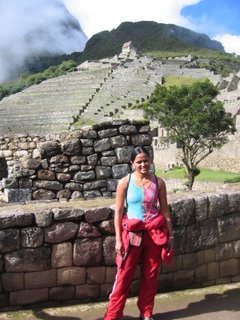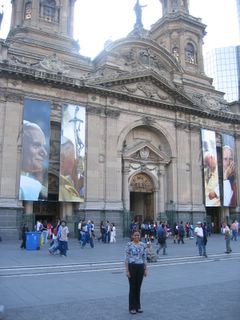Our return to California was as reluctant as the winter rains in the Amazon. But, as a rule, gypsies cannot stay put in any one place. For the moment, we’re overjoyed to be reunited with our family and friends.
The babies are growing up so fast. Nathan has just completed his first birthday. He’s waddling along perfectly on his two little feet. His days are just packed playing with Parul and Thatha, steering his red tricycle, and furiously pushing his blue walker. Imagine that he walked around Castro Street with us for almost an hour exploring every little nut, bolt, fence, wheel, and pebble he set eyes on. He knows us by our names and identifies us just the way he points out the clock, fan, and Nathan Good Boy. We take with us the picture of him sitting on a high chair at a restaurant during dinner where he gently folds his blanket and put his head on down on the table to indicate that he's tired.
Pushka, as we call our dearest Anoushka, is our darling angel. We miss spending time with her making her laugh incessantly or just plain cuddling her. We picture her sitting on the couch snuggled between two cushions peaceful as a princess or mischievously grinning at us from her bouncer or thoroughly pleased during her bath service. And Trisha, aren’t you growing into a pretty pretty doll. Our favorite moment was when the two little darlings shared the same chair and Trisha cuddled up to her newest friend to hide from mommy’s over-enthusiastic bid to extract a smile.
Despite all these ties, life also feels strange back "home". What makes a place "home"? Friends and family certainly make us feel like we're back. But we really miss going back to our own apartment, which by the way (we went back to check) still remains unoccupied since we left. For once, we land back without stressing about work piling up in the office. But oddly enough that stress breeds familiarity, a sense of arriving back. We’ve traded "home" for our "banjara" existence. And this is probably the first time this reality hit home.
Returning to the United States also disconnects us from our vacation world. The past two months seem like they never happened probably because nothing much has changed back home. Other than the babies, little else has made progress. Is this the way things will feel when we finally stop traveling? It’s a question that buzzes around our minds like an annoying little bee. There’s no doubt that we’ll miss the thrill of moving on every day, at least geographically, and planning our next move.
Not surprisingly then, we fly out of United States barely a week after we return. Our plan is to gather all our visas in India while spending time with our families there. Meanwhile, we’re making a totally unplanned pit-stop in Thailand and Cambodia.
Monday, April 25, 2005
Monday, April 18, 2005
Condors at Colca

Colca canyon is supposed to be the deepest canyon in the world, deeper even than the Grand Canyon. Although it lacks the glamour of its Arizona counterpart, the Colca valley is truly spectacular and renowned for watching condors up, close, and personal.
From Arequipa to Chivay, we made our journey up to a height of 5000 meters in a van stuffed with twelve people. Our guide Cesar was a character. Ever since our travels in Turkey, we've instinctively developed a distrust for all those that start their sentence with "Friends". We just flinched every time Cesar addressed us as "friends". The van had an international flavor to it: French, Chilean, Peruvian, Portuguese, and Brit. On the road we introduced ourselves and talked about what we were hoping to get out of the trip. Nagesh was really eager to see the condors.

The drive to Chivay - the city of love - meandered through the Andean range with lunar landscapes and volcanic peaks rising upto 6000 meters. We stopped off at several vistas speckled with herds of Llamas, Vicunas, and Alpacas. Alpacas are the cute ones, Vicunas shy and slender whose wool is the finest and most expensive, while the Llamas are known to be the proud brats.
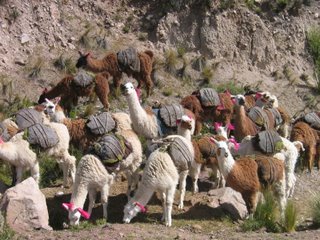
Early in the day our guide lost some of his audience when he got into an argument with a fellow traveler who used the term "Indian" generically to describe native Peruvians. Through the rest of the journey we were sniggering in the back like kids in a classroom whenever Cesar spoke. His favorite pastime was to ask "Senorita Rita" if she had "alguna pregunta" (any question). Enroute we drove past the peak Mismi where the Amazon is born. It's so amazing how a stream of melting ice turns into the mighty Amazon before joining the Atlantic.

At 5000 meters, we were intrigued by unique configurations of tapering rocks stacked on either sides of the highway. As soon as we heard that these piles were built for good luck, we promptly assembled our own little tower. There’s something about this place that we shall carry in our hearts forever. The air at this altitude was thin and crisp. Cesar distributed handfuls of coca leaves to help us along. Some chose to stick it to their foreheads, Nagesh chewed his leaves like paan and swallowed them despite instructions to the contrary from Cesar (he survived!), and Kavita simply tucked hers away in a notebook as a memento of this wonderful trip.
Chivay is a dusty town with little to talk about. Later that afternoon, we headed to the local hot springs set outdoors amidst the splendors of nature. The day came to an end with dinner at a local restaurant accompanied by a traditional dance show.
It was condor country bright and early next morning. We passed several Inca terraces still in use for farming. And then…Colca canyon stretched out beyond our deepest imagination. The Condor cross was swarming not with condors but with tourists perched precariously over the rim for one glimpse of the mighty bird. In the Incan pyramid of life, the condor signifies the highest order, closest to God.
The condor cross structurally creates a wind tunnel conducive to the condor’s flight. But where were the birds? After admiring the emptiness of the canyon for a good half-hour, we were rewarded by the most graceful swoop of a majestic condor. With its wing length spanning a colossal six feet, the bird performed a fly-by to a cheering audience. It's a miracle that Nagesh did not fall into the canyon trying to capture every flap on his camera.

There was something soulful about this experience. We tied up the day with a fifteen minute meditation in worship and quiet contemplation of God's creations.
Sunday, April 17, 2005
Amantani: Back to Basics

Spectacularly set amidst the indigo blue waters of Lake Titicaca, the rocky and rural island of Amantani seems larger than life. As the boat approaches the docks, Julio prepares us for a meeting with our island "fathers" and "mothers". As part of the true Peruvian experience, a local island family will adopt us for a night.
The fathers and mothers are waiting for us in traditional costumes of colorful ponchos, layered skirts, and embroidered shirts. They step forward to claim us when their names are called out. There seems to be some confusion regarding the pairing but it all works out in the end.
To Kavita’s disappointment, we're escorted "home" by a stiff and tacit father rather than a plump and warm mother like most others. Our home, as our father points out, sits on top of a hill offering stunning views of the lake. But following up the rough terrain at an attitude of 3500 meters is a challenge to our lungs every step of the way.
Our home is a modest two-storey brick hut with a small courtyard. The kitchen is removed from the main house and the bathroom lies completely outside the compound wall. Our room on the first floor is basic but clean and well decorated with Peruvian woven bedspreads. One solitary window overlooks the entire expanse of the lake.
While Nagesh was adjusting to the ultra low roof, Kavita anxiously waited for the mother to arrive and bring us some lunch. But she was nowhere to be seen. Following her curiosity, Kavita tried to peep into the kitchen where a big fat rodent greeted her instead of the lady of the house. Well, so much for our appetite. Minutes later, a short, very stiff looking lady walked by into the kitchen.
Kavita wanted to help out with lunch. Remember those ‘Learn Java in 24 Hours’ guidebooks, well this was our version of "peruvian cultural immersion" in 24 hours. But we should have read ‘Cooking in the Villages for Dummies’ before Kavita ventured into the pitch-black kitchen. Getting the fire started was no mean affair. The firewood smoked up the room causing tears to flow unhindered. So much for ignoring mother’s warnings and over enthusiasm! Smoke, large rodents, and a stern mother were not what we had bargained for.
Anyway, Kavita soon broke the ice (with her broken Spanish) and got chatting with the mother who seemed pleased to find out that we were married and not just dating. She spoke about her two kids who were at school but really had no careers awaiting them on the island. Tourism brings in most of the revenues and the kitchen garden supplies all the vegetables. No meat is cooked on the island.
A few minutes later, feeling left out, Nagesh joined the party. His first impression of the kitchen was rustic. As his pupils adjusted, he saw dark charcoal walls with twigs and dry leaves in one corner and potatoes in another. Kavita was sitting on a platform made of mud. The cooking range was a six-holed multi-tiered earthen cavity. There was water boiling in one pot and some other liquid bubbling on the other. The kitchen grew quiet…umm strange men were not very welcome. We were better off waiting for lunch in our room upstairs.
After an eternity, father arrived with our first course. Quinoa soup. We looked at each other with an oh-no-not-again sigh. This staple Peruvian lentil had been showing up in all our meals for the past ten days. We were getting tired of it. But the thought of mother’s kitchen and all her efforts made us swallow the soup down appreciatively. Our second course was a bowl full of whole boiled potatoes without the slightest taste or salt or spice. Words failed us. As Nagesh attempted a stab at the entrée, Kavita broke down in tears. Overcome by a wave of nostalgia, she regretted all the times she’d given her granny a run around the house, fussing over perfectly delicious home-cooked meals. We worked our way through the hard-boiled tuber meal in emotional silence. Nagesh gulped his food down choking with emotion at the thought of this being the daily diet of our hosts. On a lighter note, eating less would ensure fewer trips to the flush-less toilet outside. For every use of which we had to fill a plastic container with water to manually flush the potty-like contraption.
At five that evening, we met our tour group for a hike up to the temple of pachamama(mother earth). Sniffing munia herbs to ease the effects of altitude, we made it to the peak for a most rewarding sunset.
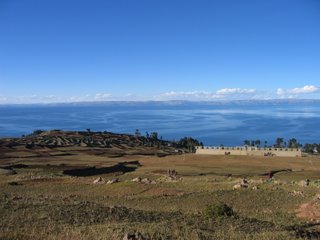
Later that night, the mother brought us a stack of traditional robes and invited us to a dance party. She helped Kavita into two layers of black and red fluffy woolen skirts secured with an intricately embroidered waistband. A white embroidered shirt completed the ensemble. Nagesh claims he resembled a ‘bahadur’, or a Nepali sherpa, in his poncho and woolen Peruvian cap. Our family also dressed up for the ocassion.

We were escorted to the venue of the party with the help of flashlights. There’s no electricity on the island. At the school auditorium, there was a live band featuring Peruvian flutes and drums ready to set the party rolling. It was exciting to see the entire tour group dressed up. We all blended in perfectly except for those dead give-away hiking boots. What followed was a cornucopia of island revelry. Led by our families, we danced and spun around the room in mad circles. Boy, it takes some effort to jive to local beats at this altitude! As the party got more frantic, the dancing shifted outdoors circling a bonfire. There was not a single pair of feet standing still.

Next morning. Subah ka hai waqt aur dabba haath mein (It's time to potty and he has a container in his hand). It was that time of the day and Nagesh was spotted rushing with a jug of water in hand from the kitchen to you know where!
Lake Titicaca: High Waters
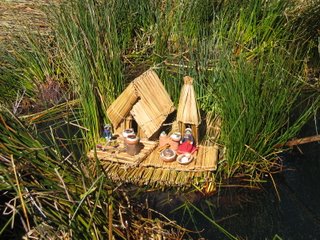
We made our way from Cuzco to Puno in what our travel agent described as the "non-tourist" bus. We later discovered that this meant no AC, no bathrooms in the bus, and hordes of local travelers (most of whom sat themselves along the aisles when the seats got full). It was nearly sunset when we drove along the incredible Peruvian countryside painted with green hills and tiny villages cramped with red roofs. The church is always the tallest building and Incan trapezoidal doors, built as such for good luck, characterize most homes. Plump women in fluffy black embroidered skirts and typical Peruvian hats briskly drive the cattle home. They all have multi-colored shawls strapped across one shoulder lugging everything from children to lambs to handicrafts to vegetables. Little children play outside without a care in the world. Painted on mud walls, ads for Inca Cola and Cusquena beer rush by.
No one announces names of the stops. Nervous about missing ours, we make it a point to ask the locals every time the bus halts and hop off when we reach Puno. We spent the night at a hospedaje run by a most delightful lady who, later, walked us right into downtown in search of dinner and, much later, packed us into bed with hot water bottles. She talked about the harsh weather in Puno, the Quechua people who inhabit the area, and how we’re the first hindu guests she’s proudly hosting.
True to tradition, our tour van collects us next morning and takes us to Lake Titicaca. En route, we stop off to buy fruits, candy, water, and other supplies that are scarce on the islands we’re touring for the next couple of days. Our first view of the highest navigable lake in the world is devoid of any wonder. Looks ordinary enough, except that we’re at an altitude of 3000 meters. Along with Julio, our guide, and fifteen other travelers, we set sail for Uros or the floating islands on this gorgeous day.
We gasp as we spot clusters of golden islands floating on crisp blue waters of the lake. Platforms of reed or tall dried grass support five to seven huts each. Local women greet us in Quechua as we step onto the surprisingly stable 20X20 island. We settle down in a circle on the straw floor while Julio talks about the Uros and its people. A layer of the dried reed is added to the island floor each week to thicken its base and keep the islands dry. The islands themselves last around twenty years after which the families move onto new ones. To ensure that the islands don’t float away to Bolivia, or the "caca" side as Julio jokes, they are hoisted upon firm stakes. It’s almost like a city on water, with floating neighborhoods.

Julio serves us the local snack called the "island banana" which closely resembles a sugar cane but tastes like… well… nothing. Our eyes are drawn towards the poori-like bread that an elderly woman is frying in the open. She uses earthenware for cooking and an earthen stove fired up using … you guessed it… dried reed.

Dotting the surrounding waters are long reed boats in fancy shapes to navigate from one floating island to the other. A dollar a pop transports us to the largest island in the bobbing city. We’d heard that the islands were floating tourist traps with the locals swarming visitors and forcing them to buy handicrafts. To the contrary, we don’t feel harassed at all and thoroughly enjoy the experience.
Nature and people continue to amaze us as we embark on a long three-hour cruise to the volcanic island of Amantani.
Adventures in The Amazon: Day Three

By this time Percy’s commands had become second nature to us, although the Norwegians confessed that they were having a tough time taking orders. The next morning was ripe with ebullient sunshine. We were only too happy to hide away in the forest. Nagesh found a swing in the jungle, a la Tarzan, while Elmer shimmied up a tree to retrieve a green fruit. He then dipped a toothpick into the juices of the "tattoo" fruit before practicing his art on our hands. We looked on incredulously as he etched invisible shapes from the colorless liquid. But exactly as promised, a snake and a flower came alive on each of our hands, taking on jet-black outlines within an hour. Our tattoos lasted ten days.
Fishing was foremost on our agenda this morning. We rowed up the muddy waters of the shallow Gamitana river and anchored the boat under a shady tree. On a nearby boat, a father and daughter team was fishing and washing clothes. Their son, barely seven or eight years old, was standing ashore and expertly throwing in his fishing line. He’d already caught his lunch.
Elmer prepared our fishing rods; pieces of meat tied to hooks fastened to the ends of long wooden sticks. We all threw in our lines and waited in somnolent silence for a tug. Just as we were dozing off on the edge of our boat, Elmer caused a stir. We all stood up in excitement as he pulled up a big catfish struggling helplessly at the end of his line.
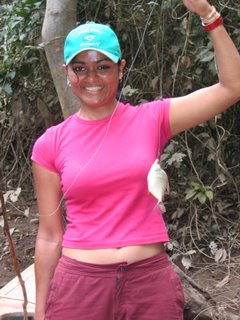
Inspired by his success, Kavita threw in her line in the same direction. She could feel some tugs but nothing each time she pulled up her line. Extreme patience in mind-dulling heat was about to pay off a few minutes later when she heaved out her line showing off a perfect little silver fish. Crazy with excitement, she began jumping up and down, rocking the boat wildly and destroying anyone else's chances of ever landing a catch. Meanwhile Nagesh, who was more concerned about losing the fish, rapidly goaded her to bring the catch into the boat. The ecstatic beginner first posed with her prize before handing it over to Elmer for cleaning.
Percy conducted our last activity that evening walking us around a medicinal garden in the lodge. The plants and shrubs grown here can cure anything from snakebites to altitude sickness.
 Our fantastic hosts : Percy the manager and Elmer our ranger.
Our fantastic hosts : Percy the manager and Elmer our ranger.
Saturday, April 16, 2005
The Wonders of the Amazon Jungle

Wake up this morning was at 5am (groan). Percy’s orders and Elmer was banging our door down on the dot. Nights in the Amazon are absolutely still and humid. Sleep arrived very reluctantly and was only making itself comfortable towards the coolness of dawn when Elmer’s banging kicked it out rudely.
By 6am we were on the boat with our goody bags filled with banana chips courtesy of the lodge. The sun was feeling a little lazy this morning, which made it relatively less hot for the first few hours of our trek through the impenetrable forest. Besides Elmer, we were in the excellent company of our Norwegian friends. This morning, we discovered several types of palm trees used for building roofs of houses and lodges - and decorative skirts for tourists. While Kavita sported her Amazonian skirt, the guys took bets on how long it would last.

Elmer, who was ingenious around these parts, broke off a long piece of wood and teased it into a hole in the ground. A giant black tarantula, also disturbed out of its peaceful slumber, crawled out in a bad mood. We got away as soon as we could. It’s amazing to think how Elmer knows every nook and cranny of the forest. The birds had begun to herald another busy day in the jungle by their loud cawing. Macaws, toucans, parrots, pelicans were all making a humbug in the highest reaches of the trees. A rare sloth, true to its name, lay lazing on a high branch somewhere.
Two at a time commanded Elmer. Our next destination was a tree house 60 feet above ground. The spiral staircase around the fig tree was tight and rickety. At the very top, the steps got narrower and tougher to maneuver with each cracking stair threatening to cave under us. The platform on top was squarely set amidst the highest treetops offering a panoramic 360-degree view.

Our binocular sweep suddenly spotted fuzzy mounds attached to tree branches not unlike the rare sloth we’d spotted earlier. We could clearly distinguish the shape of their bodies. Excited, we waited another ten minutes, watched a few vultures and toucans up close before making our way down. "Elmer we spotted two sloths!" we shouted. Elmer was full of disbelief and ready to bolt up the tree to challenge our find. Nagesh panted up after him for the second time only to hear him laugh and shout "termite mounds’. So much for getting up there twice!
Our next leg was to navigate the Amazonian backwaters and swamps. We clambered onto a canoe that was magically waiting for us at the end of our path. Armed with one large stick and an oar, Elmer navigated us around the hairpin water bends. Nagesh and the Norwegians decided to pitch in some muscle power as well. But the Norwegians were disappointed about not encountering any anacondas. Elmer says they’re easier to spot during the dry season when the waters are shallow. But we did spot lots of caimans as close as three feet away. Kavita’s favorites were the shy turtles that like to hang out on rocks and jump in as soon as they suspect visitors.

After an hour, we were back to hiking a short section of the forest after which another canoe awaited us, this time with enough paddles for everyone. Initially, we were all excited to row through the lush green aquatic vegetation, but after an hour in the hot sun, our energies began to flag. The ubiquitous green glowed oppressively in the harsh sun and the canoe seemed to drift in slow motion. After what seemed like an eon, we made it back to terra firma. On our hike back, we were rewarded by glimpses of a frolicking river otter making loud splashing sounds, cavorting in and out of the river.
Percy greeted us at the resort and instructed us to be ready for a visit to a local jungle family after lunch. Talk about taking a break! This afternoon we were treated to a special lunch: a rice dish delicately spiced and steamed in a banana leaf. As we opened our individual leaf bundles, the aroma of garlic, ginger, and nutmeg filled the air for us to relish every bite.
Friday, April 15, 2005
Creatures of the Night

Eco Amazonia lodge has a wonderful lounge area with a bar adjoining the dining room. We played several competitive rounds of foosball in here until a special visitor, who puts in a daily appearance around this time, stumped us. A hefty Amazonian Tapir(looks like a huge dark grey pig) barged into the lounge making a beeline for the bar as shell-shocked admirers started to throng around. Talk about surprises! But wait, he wasn’t headed to get a drink, only his favorite snack of miniature bananas. Soon after, the guests were taking turns feeding the Tapir and capturing Kodak moments.
Percy interrupted us during dinner that evening. Again, we only had "five minutes" to meet Elmer outside if we wanted to see Caimans in the dark. Elmer was sporting a gigantic flashlight as he guided us to the boat in pitch darkness. Some distance from the lodge, the boat was powered off and the dead silence provided perfect acoustics for the jungle chorus. We were not the only ones listening. A zillion stars studded the sky on this perfectly clear night. Our Norwegian friends were quick to point out the Southern Cross. This is truly a stargazer’s paradise!
Caimans are smaller cousins of the crocodiles usually found along riverbanks, slyly awaiting their innocent prey. Elmer swept his flashlight along the banks hoping to get lucky. And then we spotted one… no two bright red glowing dots on the surface while the rest of the creature lay submerged in water. We held our breath in excitement as our boat sneaked up as close as possible. Mission successful, we returned to the lodge.
There’s no electricity in the cottages except in the dining hall, where you can charge all your contraptions. At dusk each day, a lantern is set outside each cottage and needs to be placed back out before you go to sleep. Finally, it was time for us to detoxify from the deet and sweat. No shower has ever felt more satisfying, but the joy was short-lived as we sprawled out on our beds dreaming of air conditioners.
The Monkey Island

"You must all assemble at the reception hall at 3pm for the Monkey Island trip", said Percy. The first of the incessant commands he would issue in the next four days. Percy is a very organized and meticulous day planner who smashed all our dreams of idling around for the rest of our trip.
We barely got a chance to enjoy our jungle lodge called ‘Toucan’ (an Amazonian bird). Made entirely of wood, the living room was furnished with two cloth hammocks. Our bedroom had tall-beamed ceilings and light pouring in from its highly placed windows. The dank, woody smell of our home continued into the attached bathroom, also built entirely of wood. Luckily, we had flush toilets, albeit filled with muddy brown water. The shower is heaven only as long as you stand under it. Sweat drenches you the second you step out.

Anyway, we could no longer postpone spraying the vile smelling Deet (mosquito repellant). Kavita dressed in light black pants topped with a cotton t-shirt, convinced that covering her limbs would fend off any insect attacks. She would stand corrected shortly.
A long-tailed boat waited at the docks to transport us to the nearby monkey island. It rocked precariously as we clambered on and arranged ourselves evenly on either side to keep it in balance. At the island, we met our guide Elmer for the first time. Machete in one hand and a bag full of mini-bananas in the other, he confidently led the way ensuring us that the monkeys were waiting for their afternoon snack. "Platano, platano!!!" he shouted a couple of 100 meters into the thick of the forest. Nothing. After he relayed a few more "bananas are here" messages, we heard furious rustling sounds echoing through the forests followed by the chattering of monkeys.
The long-tailed black capuchin monkey was the first bold creature to come in search of his snack. Elmer threw several bananas and the dude tried to grab them all before pealing them carefully and gulping them down in a flash. Several other species of monkeys slowly made their way near our group, some shy, some defiant, some challenging, some greedy, but all so fascinating to watch at barely an arm’s length away. Our favorite was the lion-faced monkey, the tiniest little fluff ball, who perched himself on Elmer’s shoulder until he had his fill.

After a half hour of close encounter with the simians, Elmer took us on a mini-exploration of the jungle. His machete came in handy any time he had to chop off branches and clear the way through the thick vegetation. We met the giant garlic tree - yes garlic isn’t just a bulb that grows underground - in the Amazon you can chop off the barks of garlic trees and use them to flavor your cooking. If you’re bad in the Amazon, you will be tied to the "punishment" tree whose trunk is filled with notorious Amazonian red ants. A simple theft gets you two hours around the tree and a major offense ensures an overnight stay that can lead to death.
Meanwhile, the mosquitoes had decided to harass Kavita. The light pants were no armor and by the end of the evening she had fifty souvenir bites on each thigh and all along her arms. Apparently, even clothes need to be sprayed with deet, not just exposed body parts. And yes, these are bites that swell to the size of eggs in a few hours. They did subside after a few days.

After some more interesting explorations, we came to a marshy clearing filled with tall grasses but no trees. The sun was inviting us for a spectacular light show of bright amber rays. We sat down on fallen tree trunks nearby to enjoy our first Amazonian sunset.
Arriving at the Peruvian Amazon

The flight from Cuzco to Puerto Maldonado was a short half hour but long enough for the plane to cross a mountain and for the landscape to change from the hilly reds to lush greens as far as the eye could see. Thick, murky waters of the Amazon sliced the verdant equatorial forests. And thick humidity pierced the air around us as soon as we emerged from our plane onto the small tarmac. Fellow travelers promptly began to spray mosquito repellants and slap on the sunscreen while waiting for the luggage to arrive. We followed suit as if the insects would attack us as soon as we stepped out of the building. So much for acting paranoid without reason… we were nowhere near the jungle yet.
Outside, a guide stood bearing the name of our Eco Amazonia lodge. We waited for the rest of the group to assemble before riding into town in our open safari van. Our guide took us on an excursion to the local market to lend us a flavor for indigenous produce. The market almost had an island feel to it. There were mounds and mounds of fresh fruit heaped up attractively: several sizes and varieties of bananas, mangos, pineapples, and fruits we’d never seen before. Nagesh went about tasting all the unfamiliar fruits.

Also in abundance were countless varieties of potatoes, yams, green bananas, and other vegetables. Adding to the colors were nylon shopping bags and gunnies in rainbow colors suspended from every other shop. Some of our trip mates picked up at least fifty of these as souvenirs.

After an hour or so, we were at the port boarding our long-tail speedboat to the lodge. The smell of freshly cut timber, being transported for construction work at the lodge, filled the vessel. The breeze alleviated some of the oppressive hundred percent humidity and the ubiquitous green color had such a calming effect that we began to hallucinate about spending the next four days lounging around on hammocks. After a monotonous two hour boat ride, we docked at our gorgeous lodge. Percy, the manager, was waiting for us with welcome drinks. We greeted him with enthusiasm little realizing that he would be responsible for smashing our recent dreams.
Wednesday, April 13, 2005
Machu Picchu: The Lost City of the Incas
We heave ourselves over the last few steps on the Inca trail. They’re no less exhausting than the countless ones we’ve scaled but this time things are different. We’re almost at Intipunku, the sun gate that promises us the first view of Machu Picchu (or old moutain). As we applaud each other for making it to the summit, our glee turns to disappointment. Machu Picchu lies hidden behind a thick low-lying cloud cover. We wait for a while before continuing on the trail, supposedly veering towards the fabled city. And then, by what Nagesh claims to be the power of a promised sacrifice to the Inca gods (let's not ask what he promised in sacrifice), the clouds turn to ether. A most dramatic clearing act uncovers the secret city of the Incas. Machu Picchu quite simply leaves us spellbound!
The hike up the inca trail is worth every step in gold. Although the sheer beauty of the Urubamba valley more than makes up for the near-death exhaustion at some points, the crown prize just obliterates all previous pains and pleasures. This must also be the reason why we decided to scale Huayna Picchu (or new mountain) and it's near vertical steps after all this hiking. Spurred by the promise of a greater view of Machu Picchu, the steep climb up the slippery steps of this sheer cliff was rewarded by absolutely breathtaking views. Albeit our knees did not share in the excitement one bit.
The Incas built Machu Picchu to protect themselves from Spanish invaders. This inaccessible site is nestled between tall lush green mountains in a valley pierced by the Urubamba river. Because its layout seeks to maximize the sun’s energy, Machu Picchu is squarely situated between the arcs of the winter and summer solstice points of the sun. This ensures that the sun shines all day on all the buildings in the city.
Despite it’s architectural brilliance, the Incas were wiped out, perhaps due to the very isolation that protected them from their invaders. The lost city was not unearthed until the early 20th century when Hiram Bingham found it buried under a forest. According to our tour guide, he was a "thief" who transported all his Inca finds (including some 106 mummies) outside Peru. Thief or not, he did uncover one of the greatest historical wonders of all time.
What happened to the Incas? How were they wiped out? How did they build this city? What was life like in Machu Picchu? There are as many theories on all these natural questions as the number of guides offering interpretations. And the answers are as varied and confusing as the countless labrynths inside the surviving walls. There are just no clear or definitive answers. As Nagesh says, this is where the Egyptians prove to be a far superior race that documented every detail of their lives through hieroglyphics.
And that is why it becomes important that we document our travels through this blog so posterity will never have a doubt about our trip to Machu Picchu in early April of the year 2005.
The hike up the inca trail is worth every step in gold. Although the sheer beauty of the Urubamba valley more than makes up for the near-death exhaustion at some points, the crown prize just obliterates all previous pains and pleasures. This must also be the reason why we decided to scale Huayna Picchu (or new mountain) and it's near vertical steps after all this hiking. Spurred by the promise of a greater view of Machu Picchu, the steep climb up the slippery steps of this sheer cliff was rewarded by absolutely breathtaking views. Albeit our knees did not share in the excitement one bit.
The Incas built Machu Picchu to protect themselves from Spanish invaders. This inaccessible site is nestled between tall lush green mountains in a valley pierced by the Urubamba river. Because its layout seeks to maximize the sun’s energy, Machu Picchu is squarely situated between the arcs of the winter and summer solstice points of the sun. This ensures that the sun shines all day on all the buildings in the city.
Despite it’s architectural brilliance, the Incas were wiped out, perhaps due to the very isolation that protected them from their invaders. The lost city was not unearthed until the early 20th century when Hiram Bingham found it buried under a forest. According to our tour guide, he was a "thief" who transported all his Inca finds (including some 106 mummies) outside Peru. Thief or not, he did uncover one of the greatest historical wonders of all time.
What happened to the Incas? How were they wiped out? How did they build this city? What was life like in Machu Picchu? There are as many theories on all these natural questions as the number of guides offering interpretations. And the answers are as varied and confusing as the countless labrynths inside the surviving walls. There are just no clear or definitive answers. As Nagesh says, this is where the Egyptians prove to be a far superior race that documented every detail of their lives through hieroglyphics.
And that is why it becomes important that we document our travels through this blog so posterity will never have a doubt about our trip to Machu Picchu in early April of the year 2005.
Tuesday, April 12, 2005
Sunday, April 10, 2005
Cuzco, Peru: The Center of the Inca World

The Incas believe Cuzco to be the navel of the world. For us, Cuzco was the epicenter of our Peruvian travels. From the moment we landed, Cuzco made us breathless, literally and figuratively.

Vibrant colors. cobbled stone alleys, walls of polished stones, and intricately carved wooden balconies was our first impression of this charming village-like town. Life in Cuzco radiates outward from its central Plaza de Armas; the most beautiful we’ve seen in any South American city. The perimeters of the plaza are lined with grand churches, souvenir shops, cafes, and tour operators. Look around and all of Cuzco gazes upon you from the surrounding hills teeming with red roofs.

At 3500 meters, we had to pop Diamox pills to prevent our lungs from pounding out of our chests. The altitude sickness wiped us out completely for the first few hours. So much so that we barely noticed the Halloween inspired décor of our Frankenstein Hostel. The eccentric German owner was talking endlessly in what seemed like unending slow motion. All we could do after the three-floor hike to our room was to hit the sack and acclimatize.

A few hours later, we walked in slow motion and popped in at the nearest Indian restaurant called Govinda. There’s plenty of delicious vegetarian food in Cuzco possibly because vegetables are preferable over meats in high altitudes. After struggling with bland Chilean cuisine over the past weeks, Indian curry at Govinda was delicious. After lunch, Kavita encountered coca leaves for the first time. La oja de coca es no droga announce popular souvenir t-shirts. Coca leaves are not drugs although they are the source for cocaine. Cusquenians drink coca tea just like the Argentinians enjoy their mate, any time of the day. Coca leaves brewed in boiling water improve blood circulation and reduce the effects of high altitude.
We spent the rest of the afternoon researching trips and planning our itinerary in Peru. This means hopping from one tour operator to another comparing prices and bargaining for the best deal. Now this is quite a bit of hard work considering the numerous ways you can get conned. So if you get this part right, the rest is a breeze. By the end of the evening, we had our two weeks planned and packed to the hour. Machu Pichu, Amazon, Lake Titicaca, Colca Canyon: we couldn’t wait to get started!
Friday, April 08, 2005
The Trans American Bus Journey
Beware of what you ask for in life…’cause you never know. Kavita wished for quality time with Nagesh tied to a chair and she got one better, chairs that recline!!!!!!!!!!
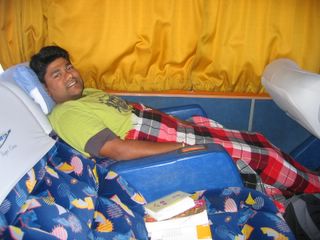

We'd undertaken twenty-two hour bus journeys earlier in the trip but this time we were working on a ride of a lifetime. Dollares more than any craving for adventure landed us at the ticket counter of in Rio’s Rodoviaria (central bus station). Dos boletos por favor. From Rio de Janeiro, Brazil to Santiago, Chile. Yes, we were taking a sixty-hour bus journey from the Atlantic coast to the Pacific cutting across South America with only 20 dollars in our pockets.


The journey was truly memorable, passing through distinct landscapes, from the Equatorial belt to the dramatic Andes. The climax was riding across Aconcagua, the highest peak in the Americas, while crossing into Chile via the Libertadores Pass and its 59 hairpin bends carved into the Andes.
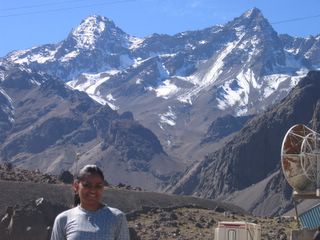

Getting our passports stamped through the borders as we exited one country and entered another was adventure in itself. Especially when the couple seated behind us on the bus was arrested at the Chilean border for carrying contraband goods. We sat still as statues while police dogs sniffed out the entire bus in the aftermath of the discovery; praying all the while that the canines wouldn’t jump at our throats by mistake. We found our voices promptly after they left to indulge in horrified gossip with fellow travelers about the fate of the unfortunate couple.
Statutory Warning: This journey must be undertaken once, but only once, in a lifetime. And only if you possess an iPod, an iron butt, and infinite love for the person sitting next to you.


We'd undertaken twenty-two hour bus journeys earlier in the trip but this time we were working on a ride of a lifetime. Dollares more than any craving for adventure landed us at the ticket counter of in Rio’s Rodoviaria (central bus station). Dos boletos por favor. From Rio de Janeiro, Brazil to Santiago, Chile. Yes, we were taking a sixty-hour bus journey from the Atlantic coast to the Pacific cutting across South America with only 20 dollars in our pockets.


The journey was truly memorable, passing through distinct landscapes, from the Equatorial belt to the dramatic Andes. The climax was riding across Aconcagua, the highest peak in the Americas, while crossing into Chile via the Libertadores Pass and its 59 hairpin bends carved into the Andes.


Getting our passports stamped through the borders as we exited one country and entered another was adventure in itself. Especially when the couple seated behind us on the bus was arrested at the Chilean border for carrying contraband goods. We sat still as statues while police dogs sniffed out the entire bus in the aftermath of the discovery; praying all the while that the canines wouldn’t jump at our throats by mistake. We found our voices promptly after they left to indulge in horrified gossip with fellow travelers about the fate of the unfortunate couple.
Statutory Warning: This journey must be undertaken once, but only once, in a lifetime. And only if you possess an iPod, an iron butt, and infinite love for the person sitting next to you.
Subscribe to:
Comments (Atom)

